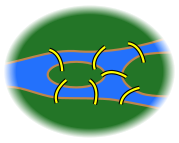Graph Theory/Introduction

Graph theory studies the properties of various graphs. Graphs can be used to model many situations in the real world, for example:
- the users of a social network and their friendships;
- the cities in a country and the streets that connect them;
- telecomunication networks, like the Internet and the World Wide Web;
- linguistic structure, for example syntactic structure of a sentence;
- project management, to manage dependencies between tasks;
- bioinformatics: protein-protein interaction, residue interaction network, gene regulation;
- mathematical relationships like Fibonacci expansions using trees;
- decisions trees and Bayesian networks;
- electronic circuits: Kirchhoff laws are deeply related with the graph structure of circuits;
- and many others.
Seven Bridges of Königsberg
[edit | edit source]The most famous and most ancient real world problem was about the Seven Bridges of Königsberg. The city of Königsberg in Prussia (now Kaliningrad, Russia) was set on both sides of the Pregel River, and included two large islands which were connected to each other and the mainland by seven bridges.
The problem was to find a walk through the city that would cross each bridge once and only once. The islands could not be reached by any route other than the bridges, and every bridge must have been crossed completely every time; one could not walk halfway onto the bridge and then turn around and later cross the other half from the other side. The walk need not start and end at the same spot. Euler proved that the problem has no solution. There could be no non-retracing continuous curve that passed through all seven of the bridges. The difficulty was the development of a technique of analysis and of subsequent tests that established this assertion with mathematical rigor.
First, Euler pointed out that the choice of route inside each land mass is irrelevant. The only important feature of a route is the sequence of bridges crossed. This allowed him to reformulate the problem in abstract terms (laying the foundations of graph theory), eliminating all features except the list of land masses and the bridges connecting them. In modern terms, one replaces each land mass with an abstract "vertex" or node, and each bridge with an abstract connection, an "edge", which only serves to record which pair of vertices (land masses) is connected by that bridge. The resulting mathematical structure is called a graph.
Since only the connection information is relevant, the shape of pictorial representations of a graph may be distorted in any way, without changing the graph itself. Only the existence (or absence) of an edge between each pair of nodes is significant. For example, it does not matter whether the edges drawn are straight or curved, or whether one node is to the left or right of another.
Next, Euler observed that (except at the endpoints of the walk), whenever one enters a vertex by a bridge, one leaves the vertex by a bridge. In other words, during any walk in the graph, the number of times one enters a non-terminal vertex equals the number of times one leaves it. Now, if every bridge has been traversed exactly once, it follows that, for each land mass (except possibly for the ones chosen for the start and finish), the number of bridges touching that land mass must be even (half of them, in the particular traversal, will be traversed "toward" the landmass; the other half, "away" from it). However, all four of the land masses in the original problem are touched by an odd number of bridges (one is touched by 5 bridges, and each of the other three is touched by 3). Since, at most, two land masses can serve as the endpoints of a putative walk, the proposition of a walk traversing each bridge once leads to a contradiction.
In modern language, Euler shows that the possibility of a walk through a graph, traversing each edge exactly once, depends on the degrees of the nodes. The degree of a node is the number of edges touching it. Euler's argument shows that a necessary condition for the walk of the desired form is that the graph be connected and have exactly zero or two nodes of odd degree. This condition turns out also to be sufficient—a result stated by Euler and later proven by Carl Hierholzer. Such a walk is now called an Eulerian path (oy•lɛr•i•ən) or Euler walk in his honor. Further, if there are nodes of odd degree, then any Eulerian path will start at one of them and end at the other. Since the graph corresponding to historical Königsberg has four nodes of odd degree, it cannot have an Eulerian path.
An alternative form of the problem asks for a path that traverses all bridges and also has the same starting and ending point. Such a walk is called an Eulerian circuit or an Euler tour. Such a circuit exists if, and only if, the graph is connected, and there are no nodes of odd degree at all. All Eulerian circuits are also Eulerian paths, but not all Eulerian paths are Eulerian circuits.



